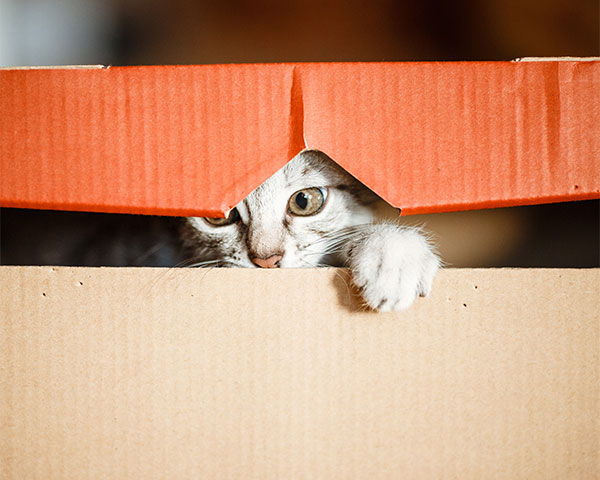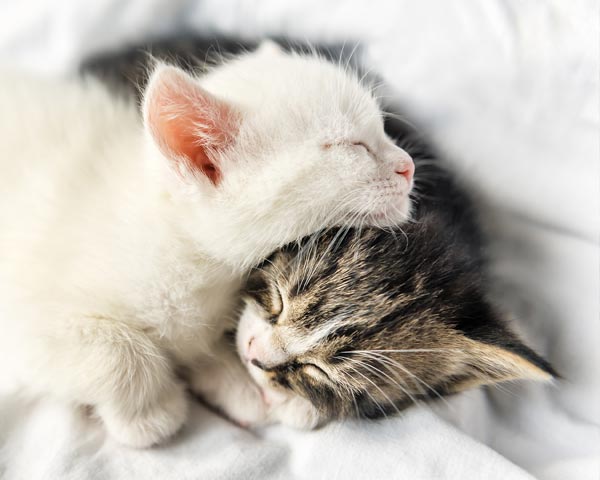November 3, 2020
November 25, 2020
June 7, 2021
August 30, 2021
It’s our Dog (and Cat!) Days of Summer! 50% off adult dog and cat adoptions! Shelters everywhere are full to the brim with adoptable animals right now (ours included!) and we’re on a mission to find a loving home for each and every one of them! Thinking about bringing home a new fuzzy family member? Now is the time! We’re offering 50% off all adult dog and cat adoption fees September 1 – 30, 2021. No coupon needed, just make an adoption appointment online. Click here to see who’s waiting to meet you!
August 24, 2023
Pretty much everyone has heard a cat hiss at some point. Many times people become concerned if they hear their cat hissing. I’ve heard cats get labeled as ‘mean’ or ‘bad’ or ‘aggressive’ if they hiss. The truth is, ANY cat will hiss under the right circumstances, and today I want you to understand one thing: A hiss is NOT a bad thing. When a cat hisses, they are saying ‘no’ or ‘back off’ or ‘I don’t like that’. There are many different circumstances in which a cat could hiss; sometimes, we have to work around it- like if a cat is at the vet and they are scared but need an important procedure done- but most of the time, when a cat hisses, it means that you need to listen to them and stop what you are doing. I’ve seen many viral videos where someone is messing with their cat in some way- scaring them with an object, poking them, or holding them in an uncomfortable position- and when the cat hisses, the person laughs and keeps doing what they are doing. I think these videos are the opposite of funny- they are quite mean and sad. I have also seen people respond to their cat hissing by yelling at them, or smacking them gently, as though they believe that the hiss is an ‘incorrect’ behavior that the cat is engaging in. We should in fact WANT our cats to hiss when they are unhappy with what is going on. It’s an excellent form of communication since they probably aren’t going to be able to learn to speak the word ‘no’ anytime soon. If a hiss is ignored, that is often when cats will proceed with swatting, biting, or otherwise attacking- and I don’t blame them for that. If we CONSISTENTLY ignore our cats’ hisses, then they might stop doing them when they are upset- and instead go straight to the biting part. We definitely don’t want to train them to stop communicating! Cats will, of course, also hiss at each other when the occasion calls for it. Turn up your volume and watch the included video for an example. These two cats are Pirate and Litty, currently available for adoption at our Santa Rosa shelter. They came from the same household and are fine living with one another, but sometimes Pirate spends a little too much time being in Litty’s personal bubble. The way she lets him know that she needs space is by hissing at him- to which he responds with a short pause, then turning and walking away. This is a GREAT interaction- Pirate respected Litty’s wish, and thus the situation was not escalated by either cat swatting the other. This same thing applies to your own cats- I talk to people who are concerned when their cats hiss at each other, and what I always ask is what happens AFTER the hiss occurs. If the cats part ways, then all that happened was likely a play session got too intense for one of the cats, and they told the other ‘no’, and there is no issue if the other cat listens. If the other cat does not RESPECT the hiss and continues trying to interact with the cat who hissed, that’s when there’s a deeper issue that you’ll need to address (and if you’re wondering, some of the main things to do for fighting cats in a household is to increase playtime, increase offered enrichment, and ensure enough resources like food, water, and litter boxes are available for all). Moral of the story is- respect a hissing cat! Just like we need other humans to respect us when we say ‘no’ to something, we need to respect our cats when they tell us ‘no’ in their own way! They are not ‘bad cats’ or ‘aggressive’ just because they hiss, and we should not treat them as such.
August 24, 2023
Everyone who has a cat has had it happen to them: they buy their pet some fun toy or a cat tree, bring it home and set it up- only for your cat to go straight for the box it came in instead. So why do cats love boxes so much? Cats’ affinity for boxes is likely based in their natural instincts. Cats are both prey and predator, and boxes can help fulfill the needs that come with being both of those things. From a prey perspective, a box provides cover from prying eyes- they’re great for concealment. For this exact same reason, cats may also be drawn to boxes from a predator perspective. Most cats are ambush predators, which means they lie in wait in a hiding spot until just the right moment comes, and then they pounce. You can use this knowledge to your advantage during playtime to keep your cat more engaged- if they go into a box, try slowly dragging a wand toy past them and see what happens. We’ve all seen cats try to cram themselves into boxes that are too small for them. One reason for this may be that they want to get warm. When we cover ourselves with blankets, they help reflect our body heat back towards us- cats may do the same with boxes, and the smaller the box, the better! Your cat may also just be acting playfully- maybe they are sticking their paw in that far too-small tissue box because their instincts are telling them it would be a good hiding spot for a mouse. There’s also an interesting thing many cats do- they will sit in the illusion of a box. Put some tape on the ground in an enclosed circle or square, and your cat might just go sit in the middle of it. Or maybe you make your bed in the morning, and then set a folded shirt or pair of pants on the blanket only to turn around and find your kitty curled up on top. There are a few hypotheses as to why this may be. One is that cats are more farsighted: they can’t see things well up close. So maybe by just seeing the outline of a ‘box’, they are thinking they are actually inside something that has raised edges. Additionally, when a cat sits on something, it’s their way of ‘claiming’ it. Cats always want their environment to smell like them, so a new object that they can claim in as easy a way of sitting on it is very appealing to them. In the case of clothing, because it smells like their person (you), they’re especially interested in mixing their scent with yours as it helps them feel comfortable and safe. Don’t worry too much if you get that expensive cat tree and your cat seems to ignore it in favor of a box- boxes are an easy, quick enrichment item that cats enjoy and know what to do with right away, but they can get boring over time. A cat tree is a long-term enrichment investment, and after they get used to it your cat will likely grow to love it. You can help them enjoy their new thing sooner by leaving treats, catnip, or familiar toys on it or next to it, or using a wand toy to encourage them to play on it.
August 24, 2023
Most cat people have offered their kitty catnip at some point, and their response is usually quite fun to watch! Scent stimulation is often overlooked with felines, and I highly recommend regularly including it in the enrichment you offer to your cats. Here are some things to know to give your feline friend as enjoyable an experience as possible.
August 24, 2023
Everyone celebrates this day a little differently- cooking food, firing up the grill, having company over- but even if you have zero activities planned, more likely than not, you’ll be able to hear fireworks from where you are- and so will your cat. What can you do to help keep your kitty safe and happy on this holiday?
August 24, 2023
I’ve written posts before about helping shy cats settle into your home, but what about ‘average’ cats? With the exception of some really outgoing and confident felines, all cats are going to take some time to feel at home with you and adjust to their new environment. In the animal shelter world, we have what we call the ‘3-3-3 Guidelines’, which offer generalized information about what you should expect in the first 3 days, the first 3 weeks, and the first 3 months after adopting a cat. Keep in mind that these are just guidelines- every cat will adjust a little differently. If you do adopt one of those super outgoing, confident felines, they’ll probably adjust much faster; if you adopt a very shy cat, it will likely take them longer. The things discussed here are what to expect for the ‘average’ cat, so don’t worry if your new family member adjusts at a slightly different speed. First 3 days What to expect: The first three days in a new environment can be scary, and your cat will likely be a little on edge, and probably want to hide- yes, even if they were affectionate when you met them at the shelter. They may not eat or drink much, or only at night; if they aren’t eating or drinking, they may not use the litter box, or they may only use it at night or when they are alone. They will not feel comfortable enough to show their true personality. What you should do: Keep them confined to a single room in your home. A bedroom, office, or other quiet room is ideal; bathrooms or laundry rooms or other rooms that can be loud and busy are not the best choice. Pick a room that you don’t have a ‘time limit’ on how long they can stay in there; if you have a family member coming to visit in two weeks and will need to be in your guest bedroom without the cat, you should NOT use that guest room as your new cat’s home base! Whatever room you choose, be sure to block off all BAD hiding spots- under the bed, in the back of a closet, and under a couch are all examples of bad hiding spots. You want to offer GOOD hiding spots such as cave-style cat beds, cardboard boxes (you can even cut holes strategically to make an awesome little setup), or even blankets draped over an open-undersided chair. You want to be sure that wherever they are hiding, you will be able to easily find them and interact with them (when they are ready). For these first few days, if your cat is just hiding the whole time, hang out in the room but don’t force attention on them. This is a great time to get them used to the sound of your voice, how you smell, and your presence in general. Be sure to provide them with everything they need in this starter room: A litter box or two (kept away from food and water); a scratcher; bedding; vertical space like a cat tree; and other toys and enrichment items. Right off the bat, you should try to establish the mealtime routine: I strongly recommend choosing set times each day and offering meals at specific times that you will be able to stick to long term. At least twice a day is what you should aim for; three times a day is even better if it works for your schedule! First 3 weeks What to expect: Your cat should be starting to settle in and adjust to the routine of food; they should be eating, drinking, and using the litter box every day.. They will likely be exploring their environment more, and may engage in behaviors such as jumping/climbing up everywhere they can reach, or scratching furniture, as they learn what boundaries exist and try to make themselves feel at home. They will start to show off their true personality more, will be more trustful of you, and will likely become more playful and be utilizing more of their enrichment (even if it’s only when you’re not in the room). What you should do: Continue to hang out with your cat in the room; if they aren’t terribly shy, they will likely be approaching you for attention, or at least willing to let you approach them in their safe spot to give some brief pets (just go slow and let them sniff your hand first, or bribe them with a tasty treat). Stick with the mealtime routine, see if they will engage with you in play, and rearrange the room as needed with anything you’ve discovered isn’t working- maybe you THOUGHT the closet door was securely shut but they found a way to worm themselves inside; or maybe they are scratching an armchair, and you need to try a different kind of scratcher and place it next to that armchair. If they aren’t using enrichment or coming out while you’re in the room with them and you’re a bit worried, check for signs that they are using things: toys being moved around, claw marks on their scratchers, things being knocked off a high shelf, etc. These are all good signs. If they are eating, drinking, and using the litter box during this phase, everything is likely going fairly well! If your cat is already acting confident, then provided you don’t have any other animals, go ahead and open the door and let them consider exploring the rest of your home. If your home is especially large, or has some rooms that you don’t want to worry about them hiding in, consider keeping some doors shut at first- for example, if they’re in your guest bedroom and your regular bedroom has a REALLY appealing closet with lots of hidey holes, keep your bedroom door shut for now. The most important thing to remember is do NOT shut the door to their ‘safe’ room- that has been established as where they are fed, where their litter is, and it smells like them and is what they are used to. They should be free to run back to it if they get spooked! Never force them to leave the room, either- wait for them to decide to explore on their own. If you DO have other animals, rather than opening up the house to your new cat, this is when you will likely be able to begin the introduction process, which you can find more information on here: https://humanesocietysoco.org/wp-content/uploads/2022/02/HSSC_Cat-Cat-Intros_2020-12.pdf for other cats, and here: https://humanesocietysoco.org/wp-content/uploads/2020/12/HSSC_Dog-Cat-Intros_2020-12.pdf for dogs. Be sure to wait until your cat seems fairly confident in their single room before you start introductions; very shy cats may take longer than 3 weeks before you can start. 3 months and beyond What to expect: Your cat will likely have adjusted to your normal routine of comings and goings, and will expect food at their regular mealtimes. They will feel confident and have a sense of ownership with you and your home, and feel like they belong there. They should be playful and interested in toys and enrichment, and both you and them will feel a bond with the other that will continue to grow! What to do: Enjoy life with your new cat! Most cats will be at least fairly well adjusted at the three month mark; you can start to move their things out of their ‘safe’ room and into the rest of your home: establish a new place you want to feed them, put their favorite cat bed in a different bedroom, and their favorite scratcher next to your couch- letting them know that they belong in the WHOLE house, not just their one room! If there is anything extra special you want to do with them- such as harness training so you can take them on walks, or teaching them to high five- this is a great time to start the process, as positive reinforcement training will help solidify the relationship you have been building. If you haven’t already started the process of introducing your new cat to any other animals you have, you should begin! Unless you were told at the time of adoption that this is a very shy or very fearful cat, they should not be spending most of their time hiding (though it is normal for cats to nap or hang out in hidey holes, or get spooked by visitors/events and temporarily go back into hiding). If your cat still seems very nervous, is very wary of any members of your household, or is showing other behaviors that are concerning to you, reach out to the shelter where you adopted them for assistance. Remember that each cat is an individual and may not adjust exactly along this timeline! It is also important to note that cats are all different in how they show affection- just because a cat doesn’t want to cuddle on your lap, this doesn’t mean there is anything ‘wrong’ with them, and it doesn’t mean you’ve done a bad job helping them adjust to your home- while many cats enjoy cuddling, others can be perfectly content to curl up at the other end of the couch, or come to you for two minutes of pets and then go nap on the cat tree in the corner- sometimes just being in the same room as you, even without interacting, is the truest show of love!
August 24, 2023
This week I’d like to talk about bringing a new cat into your home when you already have other animals. Before you decide to adopt a cat when you already have other animals, consider the practical side of things. I am definitely a person that ALWAYS wants more cats- but I recognize I am at my limit in my current living space. There simply isn’t enough space for me to provide enough litter boxes, enough water dishes, enough vertical space, or enough other enrichment to keep more than the three cats I already have happy. Other than the long-term additional supplies you will need to provide for an additional cat, you also have to think about where their initial adjustment space is going to be. Cats are going to take time to settle into their new home, and you’ll need a nice cozy room to set them up in where the other animals in the home won’t have access to them, as even if your new cat is confident and ready to explore the whole house from day one, you will still have to keep them isolated until you’ve had a chance to do proper introductions with your other animals. Many people think of a bathroom as being a good place to set up a new cat; while having them take over your bathroom might not sound inconvenient short-term, you should prepare for the possibility that the room you’re going to be using may be their main base for weeks, or even months, depending on how smoothly introductions go. Bathrooms are also normally not ideal for creating a cozy, safe environment for a cat- it can be difficult to fit a cat tree, a litter box, food and water, hidey holes, and toys. If you’re fortunate enough to have an extra-large bathroom, it could be a good option for your new kitty’s home base, but using a bedroom or office space or something else similar is usually a better choice. (Stay tuned for a future Caturday post that talks more about helping a new cat settle into your home.) Now, let’s talk more about introductions. Not doing proper introductions between animals is probably one of the most common mistakes people make. People always have this urge to rush through them- and I get it, they are a LOT of work! I think we all have heard an anecdote from someone about adopting a new cat, throwing them into a room with their other cat, and now they’re best friends. This should not be the expectation, and I NEVER recommend that introductions be conducted in this way- there is a serious risk of injury, either to one or both of the animals, and potentially to you as well if you get in the middle of an altercation. There is also the possibility that animals will seem like they are accepting each other at first, because they are confused, in shock, or otherwise just don’t understand what’s going on enough to react to it, and then a few days later issues will arise. The best way to solve problems between your animals is to prevent them from happening in the first place- if you rush things at the beginning and your animals don’t like each other, it can be VERY hard to undo things and start fresh. If you truly do find yourself with two easygoing animals who are going to like each other quickly, then you will be able to breeze through the steps of an introduction. To ensure long-term peace, it is best for both you and your animals to stick to the tried and true introduction method. HSSC has handouts available that go over the introduction process between cats, and between cats and dogs: https://humanesocietysoco.org/wp-content/uploads/2022/02/HSSC_Cat-Cat-Intros_2020-12.pdf https://humanesocietysoco.org/wp-content/uploads/2020/12/HSSC_Dog-Cat-Intros_2020-12.pdf It’s impossible to say exactly how long an introduction will take, as every animal is different. From what I have experienced, the average amount of time to go through all the steps is 3-8 weeks. You need to take the longer time into consideration when deciding what is realistic for you to do; being pleasantly surprised at the process going quickly is much better than feeling frustrated if you were hoping you’d only have to use your second bedroom as a base for the new cat for a single week. In some cases where a cat is extremely shy, it can take significantly longer for them to feel confident enough in their new space to even BEGIN the introduction process with your other animals. Be honest with yourself, and if you don’t feel you can take on the challenge of integrating a new animal into your home right now, it is 100% okay to wait until you are ready. I am a huge advocate for having multiple cats- once they are getting along and become friends, it truly does add to their quality of life- but if bringing a new cat home is going to make you more stressed, it will probably make your animals more stressed as well. Be kind to yourself, and it will help you be more kind to your animals too!
August 25, 2023
This week I’d like to talk about why we sometimes choose to adopt cats out in pairs! We often get cats at our shelter who have already been living together. Sometimes we have information from their previous people, who will tell us how well they get along and if they love being together, but sometimes we don’t have much to go on. Once these pairs have settled into our shelter, we spend a day or two watching how they interact with each other and determine if we think they should stay together. Sometimes it’s obvious that they really love each other- they’ll cuddle, groom each other, play together, and spend much of their time with the other one nearby. However, other times it’s more subtle. Some cats aren’t big cuddlers, but will feel more confident with their friend around. They may hide until their buddy has come out and started to play, and that will signal to them that things are safe and they’ll feel comfortable approaching the human with the toy. Sometimes, they’ll only want to eat if their friend is nearby. We also look for differences in behavior anytime they need to be separated (if one of them needs a medical procedure, or needs to be monitored for signs of illness). If they seem much more shy or withdrawn, or don’t want to eat or play when they normally would, that’s a great indication that they should stay together. If we’re ever in doubt as to if a pair is bonded or not, we err on the side of caution and keep them together- there are plenty of people willing to welcome two cats into their home! Taking on two cats over one can seem intimidating, and considering the practical things is important: Do you have space for enough litter boxes in your home for two cats? Are you prepared for providing double the food? However, for the day-to-day stuff like playing and enrichment, having two cats who love each other is often LESS work- having another cat around is just about the best enrichment you can provide! Even if they don’t really want to play or cuddle together, just having the other one nearby can be a great comfort. I think we’ve all had a friend in our lives who we like being around even if one of you is watching TV and the other is reading a book- well, cats can share that same sentiment! Our shelter frequently has cats that we are looking to adopt out in pairs- this information will always be listed in their ‘about me’ section on our website, and can also be found posted on their habitats in our adoption center, so if you’re looking to adopt a bonded pair it will be easy to find that information whether you’re online or in the shelter!








